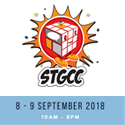BUNN & THE DAMNED: An Interview with Cullen Bunn
Cullen Bunn has frequently graced the comics world as the writer for comics such as The Sixth Gun, Harrow County, X-Men Blue, Monsters Unleashed, and Regression. We here at FlipGeeks got the opportunity to interview Cullen Bunn about The Damned, a horror noir comic he created with artist Brian Hurtt. The Damned was originally released as a miniseries in October 2006 until February 2007 with the second miniseries released in 2008. The Damned was then republished earlier this year with the addition of being colored by Bill Crabtree and was then announced to be an ongoing series.

FlipGeeks: How did you come up with the concept for The Damned?
Cullen Bunn: It’s been a while now, but I remember the earliest conversation Brian Hurtt and I had about the project. We were kicking around a number of ideas, and Brian threw out an idea for a character he had. It was a character he had been drawing for years—a scarred up gangster who wouldn’t stay dead. That character, of course, ended up becoming Eddie, the star of the series, and Brian and I built the concept for the world around him. We both loved monsters and noir stories and Thompson machine guns, so that all came together fairly easily.

The Damned has a mix of the occult and gangster crime, what is the research like? Are there any challenges for making this book?
For me, research is based around lifestyle of the prohibition era and the world of gangsters and rumrunners and tough-as-nails private investigators. I’m talking about both the factual word and the fictional world, so I probably spent less time doing historical research than I did watching old gangster flicks and reading noir novels.
The supernatural pieces of the puzzle required less research, because we’re building our own mythology here.
That said, I know that Brian does a ton of visual research so he can make the world look authentic.
I guess all of that leads to the biggest challenge with a book like The Damned. We really work to make everything feel realistic. This is a fictional world. The gangsters are more like movie thugs than real world criminals. There are demonic creatures lurking in the shadows. People are selling their souls and being cursed by the dozens. But we want readers to be immersed in the world and feel as though these things are real—at least while they’re reading the book.
The Sixth Gun was such a wonderful epic series to read. Building a believable and great world is one of them. How is the process of world building with The Damned? Does it have the similar process with The Sixth Gun?
Bunn: That’s a terrific question, but it’s one I’m not sure I can answer in any concrete way. I don’t know that there’s a formal world-building process I follow. For both The Sixth Gun and The Damned, everything was very organic. Brian and I discuss the tone of the series, and then the setting and history and mythology just starts to take shape around that. Brian might call me and throw out an idea for some aspect of the setting, or I might call him. I might come up with some element over the course of writing the script and send it to Brian to see what he thinks. Or Brian might draw something on a page that becomes a major piece of the world going forward. It’s more about building on the initial concepts in a way that just feels right.
Publishers outside the two have been very competitive in publishing many great titles, why did you choose to stay at Oni Press to publish The Damned?
Oni Press was the first publisher of The Damned and my first professional publisher. They have always treated me well, and I consider them part of my family, part of my comic book DNA. I don’t think there was ever a conversation or consideration of taking The Damned elsewhere.

You have been working with your creative team for years, what advice can you give to early collaborators?
I’ve been very lucky to work with artists like Brian Hurtt and Bill Crabtree for as long as I have. If I was going to offer advice to others hoping to build a long-lasting collaborative team, it would be to always remember you’re in the project together. Be open to ideas from your team. Don’t get too precious about any one idea you might have. There’s a lot of give and take when it comes to creating a long-lasting series. Enjoy it! It’s part of the fun!
What are your approaches in making your demons in The Damned?
In The Damned, there are three different demon families at work. We wanted each family to have very different attitudes and agendas. The Alighieri family are smooth businessmen. The Roarkes are a little rougher around the edges; they haven’t gotten the hang of business yet, but they are trying. Those two families are infatuated by the world of humans and they are embracing some very human tendencies. The Verlochin, on the other hand, are real monsters. They believe the other families have forgotten what it means to be demons. They are creepy, old world bogeymen.
Do you consider getting The Damned adapted for TV/film?
There has been lots of discussion about this. We’ve gotten close a couple of times, and I’m certain it will continue to be a topic of conversation. I’m always excited by the ideas Hollywood brings to the table when it comes to adapting a story like this. Of course, I’d love to see it!
Do you have any favorite aspects when working on The Damned?
The Damned will always be special to me because it was my first published professional work. I love the world and the characters. I love-love-love writing Eddie’s smart-mouthed dialogue and inner monologues. But—most of all—I like working on this project because I get to work with Brian Hurtt, a guy who’s been a pal for many years. I truly hope we can continue to collaborate for years to come.














